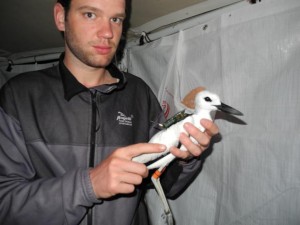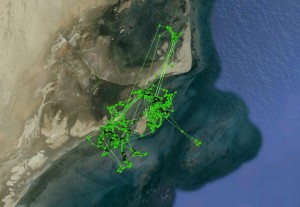Cascading predator-prey effects in a pristine seagrass-based food web in Oman
Species: Crab Plover

Roeland Bom showing a Crab plover equipped with a UvA Bird-Tracking system. The bird was caught during a pilot expedition in March 2011
In the current biodiversity decline, predators are often the first to disappear. Predators are thought to play a positive role in biodiversity maintenance as they prevent certain prey species in achieving dominance, relaxing resource competition among prey, hence promoting prey growth rates, prey coexistence and diversity. Losses of species at the highest trophic levels in communities may therefore cause extinctions and shifts in size structure at lower trophic levels. However, this role of predators is still often underappreciated, largely because many ecosystems have already lost their top-predators and/or human-induced disturbances now blur the positive predation effects.
This project aims for a better understanding of the cascading role of apex predators by studying Crab plovers Dromas ardeola foraging on crabs in Barr al Hikman, an important intertidal seagrass based ecosystem in Oman. The crabs living in Barr al Hikman are so called ‘ecosystem engineers’ because they modify their own habitat by their burrow-hiding and deposit-feeding. This bioturbating behaviour has a negative affect on erosion-sensitive species such as seagrasses. Thus any predator that feeds on crabs may potentially be beneficial for seagrasses, and thereby for the maintenance of its diverse inhabitants. Therefore, the use of space by crab-predators likely influences the spatial dynamics of these two alternative habitats.
In order to map and understand the foraging movements of Crab Plovers in the finest possible spatial scale we aim to equip 30 individuals with the UvA Bird-Tracking system. Besides location measurements, this project will rely heavily on the accelerometers to measure behaviour in Crab plovers, notably attack rates. Attack rates can be analyzed in relation to seagrass abundance and crab burrow densities, the latter can be easily mapped by burrow counting. Moreover, crabs are ideal study species in which a variety of behavioural responses in relation to their predator can be quantified readily using an experimental approach.
Contact Persons:
Roeland Bom, NIOZ, Royal Netherlands Institute for Sea Research Roeland.bom@nioz.nl.
Jan van Gils, NIOZ, Royal Netherlands Institute for Sea Research Jan.van.Gils@nioz.nl
Willem Bouten, IBED-UvA w.bouten@uva.nl
|
Roeland Bom, NIOZ, Royal Netherlands Institute for Sea Research Jan van Gils, NIOZ, Royal Netherlands Institute for Sea Research |
.
Conditions of Use: We kindly ask you to respect the intellectual property rights of the academics posting their work on this website. As such, information and content, including images and data, provided on this website may not be copied, reproduced or republished in any form without the express written permission of the UvA-BiTS manager (UvA-BiTS@uva.nl).
.
.




